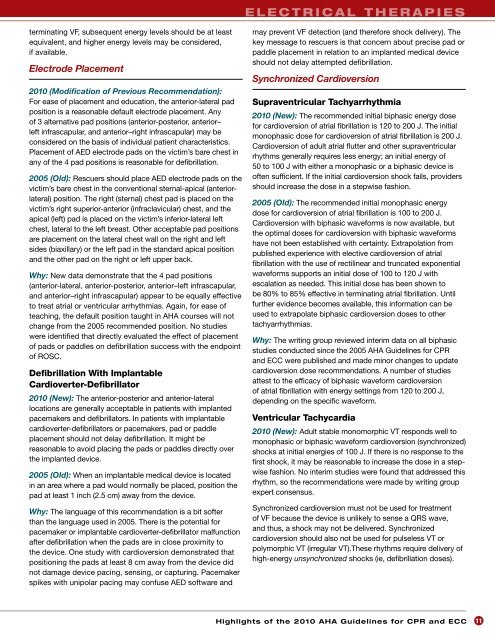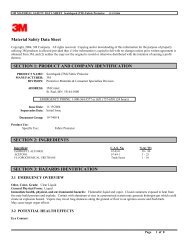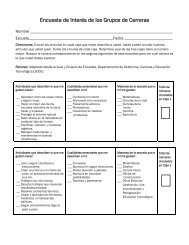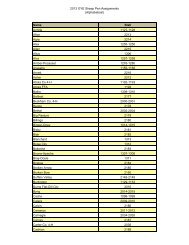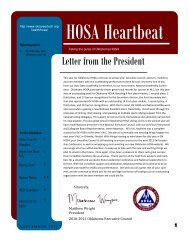Highlights of the 2010 Guidelines for CPR and ECC - ECC Guidelines
Highlights of the 2010 Guidelines for CPR and ECC - ECC Guidelines
Highlights of the 2010 Guidelines for CPR and ECC - ECC Guidelines
You also want an ePaper? Increase the reach of your titles
YUMPU automatically turns print PDFs into web optimized ePapers that Google loves.
e l e c t r i c a l t h e r a p i e s<br />
terminating VF, subsequent energy levels should be at least<br />
equivalent, <strong>and</strong> higher energy levels may be considered,<br />
if available.<br />
Electrode Placement<br />
<strong>2010</strong> (Modification <strong>of</strong> Previous Recommendation):<br />
For ease <strong>of</strong> placement <strong>and</strong> education, <strong>the</strong> anterior-lateral pad<br />
position is a reasonable default electrode placement. Any<br />
<strong>of</strong> 3 alternative pad positions (anterior-posterior, anterior–<br />
left infrascapular, <strong>and</strong> anterior–right infrascapular) may be<br />
considered on <strong>the</strong> basis <strong>of</strong> individual patient characteristics.<br />
Placement <strong>of</strong> AED electrode pads on <strong>the</strong> victim’s bare chest in<br />
any <strong>of</strong> <strong>the</strong> 4 pad positions is reasonable <strong>for</strong> defibrillation.<br />
2005 (Old): Rescuers should place AED electrode pads on <strong>the</strong><br />
victim’s bare chest in <strong>the</strong> conventional sternal-apical (anteriorlateral)<br />
position. The right (sternal) chest pad is placed on <strong>the</strong><br />
victim’s right superior-anterior (infraclavicular) chest, <strong>and</strong> <strong>the</strong><br />
apical (left) pad is placed on <strong>the</strong> victim’s inferior-lateral left<br />
chest, lateral to <strong>the</strong> left breast. O<strong>the</strong>r acceptable pad positions<br />
are placement on <strong>the</strong> lateral chest wall on <strong>the</strong> right <strong>and</strong> left<br />
sides (biaxillary) or <strong>the</strong> left pad in <strong>the</strong> st<strong>and</strong>ard apical position<br />
<strong>and</strong> <strong>the</strong> o<strong>the</strong>r pad on <strong>the</strong> right or left upper back.<br />
Why: New data demonstrate that <strong>the</strong> 4 pad positions<br />
(anterior-lateral, anterior-posterior, anterior–left infrascapular,<br />
<strong>and</strong> anterior–right infrascapular) appear to be equally effective<br />
to treat atrial or ventricular arrhythmias. Again, <strong>for</strong> ease <strong>of</strong><br />
teaching, <strong>the</strong> default position taught in AHA courses will not<br />
change from <strong>the</strong> 2005 recommended position. No studies<br />
were identified that directly evaluated <strong>the</strong> effect <strong>of</strong> placement<br />
<strong>of</strong> pads or paddles on defibrillation success with <strong>the</strong> endpoint<br />
<strong>of</strong> ROSC.<br />
Defibrillation With Implantable<br />
Cardioverter-Defibrillator<br />
<strong>2010</strong> (New): The anterior-posterior <strong>and</strong> anterior-lateral<br />
locations are generally acceptable in patients with implanted<br />
pacemakers <strong>and</strong> defibrillators. In patients with implantable<br />
cardioverter-defibrillators or pacemakers, pad or paddle<br />
placement should not delay defibrillation. It might be<br />
reasonable to avoid placing <strong>the</strong> pads or paddles directly over<br />
<strong>the</strong> implanted device.<br />
2005 (Old): When an implantable medical device is located<br />
in an area where a pad would normally be placed, position <strong>the</strong><br />
pad at least 1 inch (2.5 cm) away from <strong>the</strong> device.<br />
Why: The language <strong>of</strong> this recommendation is a bit s<strong>of</strong>ter<br />
than <strong>the</strong> language used in 2005. There is <strong>the</strong> potential <strong>for</strong><br />
pacemaker or implantable cardioverter-defibrillator malfunction<br />
after defibrillation when <strong>the</strong> pads are in close proximity to<br />
<strong>the</strong> device. One study with cardioversion demonstrated that<br />
positioning <strong>the</strong> pads at least 8 cm away from <strong>the</strong> device did<br />
not damage device pacing, sensing, or capturing. Pacemaker<br />
spikes with unipolar pacing may confuse AED s<strong>of</strong>tware <strong>and</strong><br />
may prevent VF detection (<strong>and</strong> <strong>the</strong>re<strong>for</strong>e shock delivery). The<br />
key message to rescuers is that concern about precise pad or<br />
paddle placement in relation to an implanted medical device<br />
should not delay attempted defibrillation.<br />
Synchronized Cardioversion<br />
Supraventricular Tachyarrhythmia<br />
<strong>2010</strong> (New): The recommended initial biphasic energy dose<br />
<strong>for</strong> cardioversion <strong>of</strong> atrial fibrillation is 120 to 200 J. The initial<br />
monophasic dose <strong>for</strong> cardioversion <strong>of</strong> atrial fibrillation is 200 J.<br />
Cardioversion <strong>of</strong> adult atrial flutter <strong>and</strong> o<strong>the</strong>r supraventricular<br />
rhythms generally requires less energy; an initial energy <strong>of</strong><br />
50 to 100 J with ei<strong>the</strong>r a monophasic or a biphasic device is<br />
<strong>of</strong>ten sufficient. If <strong>the</strong> initial cardioversion shock fails, providers<br />
should increase <strong>the</strong> dose in a stepwise fashion.<br />
2005 (Old): The recommended initial monophasic energy<br />
dose <strong>for</strong> cardioversion <strong>of</strong> atrial fibrillation is 100 to 200 J.<br />
Cardioversion with biphasic wave<strong>for</strong>ms is now available, but<br />
<strong>the</strong> optimal doses <strong>for</strong> cardioversion with biphasic wave<strong>for</strong>ms<br />
have not been established with certainty. Extrapolation from<br />
published experience with elective cardioversion <strong>of</strong> atrial<br />
fibrillation with <strong>the</strong> use <strong>of</strong> rectilinear <strong>and</strong> truncated exponential<br />
wave<strong>for</strong>ms supports an initial dose <strong>of</strong> 100 to 120 J with<br />
escalation as needed. This initial dose has been shown to<br />
be 80% to 85% effective in terminating atrial fibrillation. Until<br />
fur<strong>the</strong>r evidence becomes available, this in<strong>for</strong>mation can be<br />
used to extrapolate biphasic cardioversion doses to o<strong>the</strong>r<br />
tachyarrhythmias.<br />
Why: The writing group reviewed interim data on all biphasic<br />
studies conducted since <strong>the</strong> 2005 AHA <strong>Guidelines</strong> <strong>for</strong> <strong>CPR</strong><br />
<strong>and</strong> <strong>ECC</strong> were published <strong>and</strong> made minor changes to update<br />
cardioversion dose recommendations. A number <strong>of</strong> studies<br />
attest to <strong>the</strong> efficacy <strong>of</strong> biphasic wave<strong>for</strong>m cardioversion<br />
<strong>of</strong> atrial fibrillation with energy settings from 120 to 200 J,<br />
depending on <strong>the</strong> specific wave<strong>for</strong>m.<br />
Ventricular Tachycardia<br />
<strong>2010</strong> (New): Adult stable monomorphic VT responds well to<br />
monophasic or biphasic wave<strong>for</strong>m cardioversion (synchronized)<br />
shocks at initial energies <strong>of</strong> 100 J. If <strong>the</strong>re is no response to <strong>the</strong><br />
first shock, it may be reasonable to increase <strong>the</strong> dose in a stepwise<br />
fashion. No interim studies were found that addressed this<br />
rhythm, so <strong>the</strong> recommendations were made by writing group<br />
expert consensus.<br />
Synchronized cardioversion must not be used <strong>for</strong> treatment<br />
<strong>of</strong> VF because <strong>the</strong> device is unlikely to sense a QRS wave,<br />
<strong>and</strong> thus, a shock may not be delivered. Synchronized<br />
cardioversion should also not be used <strong>for</strong> pulseless VT or<br />
polymorphic VT (irregular VT).These rhythms require delivery <strong>of</strong><br />
high-energy unsynchronized shocks (ie, defibrillation doses).<br />
<strong>Highlights</strong> <strong>of</strong> <strong>the</strong> <strong>2010</strong> AHA <strong>Guidelines</strong> <strong>for</strong> <strong>CPR</strong> <strong>and</strong> <strong>ECC</strong><br />
11


